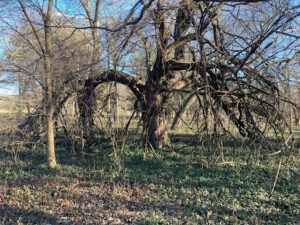By: Mark Halpin, Forestry Manager
Chestnut oak, Quercus montana (also sometimes listed as Q. prinus) is not one of the 22 oaks native to Missouri. Nor is it native to Montana; the specific epithet (the second part of the Latin name, the first being the genus) refers to its love of montane habitats. It grows on slopes, ridge tops, even right on rocks (‘rock oak’ is another one of its common names). And so like our native blackjack and post oak, often seen in small, gnarly form on rocky ‘balds’ and ‘knob tops’ it is an oak for dry, lousy soils, poor in nutrients and moisture (and intolerant or wet or compacted soils). But just like those other oaks, it can become an enormous and majestic shade tree if given more than the meager rations its demands. The resemblance to post oak continues in their growth habits; both tend to have enormous spreading crowns developing low to the ground, somewhat reminiscent of the Southern live oak (although not quite as extreme).
This low, wide canopy makes it a special kind of shade tree. While not quite as awe inspiring as the true forest giants, the closer proximity of its crown to the earthbound viewer creates a sense of intimacy and enclosure; you feel you are inside of the tree, not just underneath it. To experience this majestic feeling might make it easier to understand why some people engage in the seemingly psychotic act of climbing into trees with chainsaws for a living. (Those sturdy, low branches are also tempting enough to make even the most cautious and “grown up” adults fantasize about climbing them.) This growth habit also means that, provided you have the room to accommodate its spread, it would make an excellent lawn tree, although when it reaches maturity it may cast shade so wide and deep you won’t have much lawn left.
As the spring flower display comes to an end and summer begins, it’s worth turning your attention to shade trees and considering the quality of the shade they provide. Is it dappled, with light penetrating through (desirable if you wish to grow more sun-loving plants underneath it)? Is it deep and cool, one enormous pleasant shadow (great for those who don’t enjoy mowing their lawns)? Is it cast by a high crown, so that it moves across the ground with the path of the sun, or is it low like that of the chestnut oak so that the ground is shaded nearly from dawn until dusk? Things to ponder as you sit in the cool shade on a warm day, untroubled by more serious thoughts.
(The common name refers to the resemblance of the leaves to those of the chestnuts, genus Castanea.)




